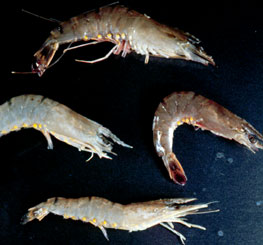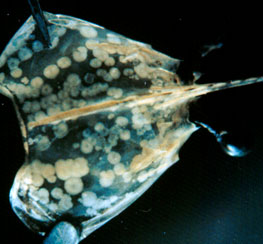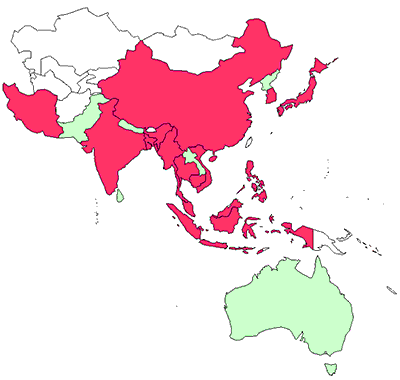Diseases of crustaceans
Viral diseases—White spot disease
CLICK ON IMAGE TO ENLARGE

Source: DV Lightner
CLICK ON IMAGE TO ENLARGE

Source: DV Lightner
Signs of disease
Important: animals with disease may show one or more of the signs below, but disease may still be present in the absence of any signs.
Disease signs at the farm level
- characterised by high and rapid mass mortality of rapid onset, mainly in farmed penaeid prawns
- can occur at any stage of the grow-out period
Disease signs at the tank and pond level
- prawns with white spot disease often do not show distinctive clinical signs
- lethargy
- cessation of feeding
- a few days later, moribund prawns near surface at edge of rearing pond
Clinical signs of disease in an infected animal
- loose shell
- white calcium deposits embedded in shell, causing white spots 0.5–2.0 mm in diameter for which the disease is named (but white spot disease can occur without these signs)
- darkened (red or pink) body surface and appendages
- heavy surface and gill fouling by external parasites
- white midgut line through abdomen of severely affected larvae and postlarvae
The shell lesions range from minute spots to discs several millimetres in diameter, and may coalesce into larger plates. They are most easily observed by removing the cuticle over the cephalothorax, scraping away any attached tissue with the thumbnail and holding the cuticle up to the light.
White spots in the cuticle are unreliable even for preliminary diagnosis of white spot disease, because similar spots can be produced by some bacteria, high alkalinity and other infectious or environmental conditions.
Disease agent
The causative agent of white spot disease is white spot syndrome virus, a large DNA virus assigned to the new genus Whispovirus (family Nimaviridae). The virus infects only crustaceans and appears not to be related to any other known viruses. It is not involved in the parasitic disease, common in finfish, also known as white spot.
Host range
All decapod crustaceans (order Decapoda), including prawns, lobsters and crabs from marine, brackish or freshwater environments, are considered susceptible to infection. However, the disease has mainly been a problem in farmed penaeid (family Penaeidae) prawns.
Crustaceans known to be susceptible white spot syndrome virus:
black tiger prawn* (Penaeus monodon)
Chinese white shrimp* (Penaeus chinensis)
Gulf banana prawn* (Penaeus merguiensis)
Indian banana prawn* (Penaeus indicus)
Kuruma prawn* (Penaeus japonicus)
Pacific white shrimp* (Penaeus vannamei)
red claw freshwater crayfish* (Cherax quadricarinatus)
blue shrimp (Penaeus stylirostris)
green tiger prawn (Penaeus semisulcatus)
White spot syndrome virus also occurs naturally in many other decapods, including:
mud crabs* (Scylla serrata, Charybdis feriatus, Portunus pelagicus, P. sanguinolentus)
sand shrimp* (Metapenaeus spp) and other arthropods
* naturally susceptible (other species have been shown to be experimentally susceptible)
Presence in Asia–Pacific

White spot disease has been officially reported from Bangladesh, Burma (Myanmar), Cambodia, China, Hong Kong, India, Indonesia, Iran, Japan, Malaysia, the Philippines, the Republic of Korea, Singapore, Thailand and Vietnam.
Epidemiology
- Although many species of crustaceans are susceptible to infection, white spot disease is mainly a disease of farmed penaeid prawns.
- High mortalities have been reported in many countries.
- Experience has shown the production of prawn farms to fall to about 40% of normal for two years, and then recover to about 70% over the long term.
- Resistance to white spot syndrome virus has not been reported for any of the penaeid species listed above.
- Infection may be low level and chronic in healthy crustaceans, or acute with disease and mortalities.
- Viral multiplication and disease appear to be induced by environmental stress.
- Vertical transmission occurs from infected broodstock, causing chronic infection in postlarvae.
- Transmission of disease is usually via cannibalism of sick or dying prawns, or directly through contaminated water.
- Many other crustaceans (such as crabs, krill, lobsters and possibly copepods) and insects are potential carriers of infection while not suffering from the disease.
- Birds can transmit the disease from pond to pond by releasing caught prawns over neighbouring ponds.
- White spot syndrome virus can persist and retain infectivity in seawater for 4–7 days.
- White spots in the cuticle are unreliable even for preliminary diagnosis of white spot disease, as similar lesions can be produced by some bacteria, high alkalinity and other infectious or environmental conditions.
Differential diagnosis
The differential diagnostic table and the list of similar diseases appearing at the bottom of each disease page refer only to the diseases covered by this field guide. Gross signs observed might well be representative of a wider range of diseases not included here. Therefore, these diagnostic aids should not be read as a guide to a definitive diagnosis, but rather as a tool to help identify the listed diseases that most closely account for the gross signs.
Similar diseases
Infectious hypodermal and haematopoietic necrosis, yellowhead disease, Taura syndrome
Sample collection
Because of uncertainty in differentiating diseases using only gross signs, and because some aquatic animal disease agents might pose a risk to humans, you should not try to collect samples unless you have been trained. Instead, you should phone your national hotline number and report your observations. If samples have to be collected, the agency taking the call will advise you on what you need to do. Local or district fisheries/veterinary authorities could advise you on sampling.
Emergency disease hotline
For your national emergency disease hotline number, see Whom to contact if you suspect a disease.
Further reading
http://www.oie.int/aac/eng/cards/en_diseasecard.htm
The currently accepted procedures for a conclusive diagnosis of white spot disease are summarised at http://www.oie.int/eng/normes/fmanual/A_00049.htm
These hyperlinks were correct and functioning at the time of publication.

